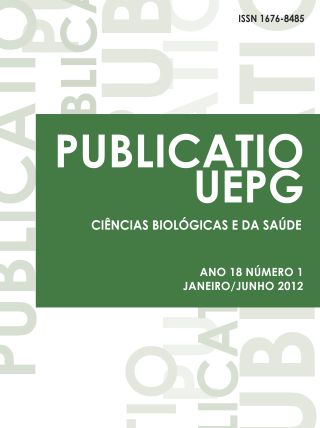Distribution of mollusc larvae in the estuarine complex of Paranaguá Bay (Paraná, Brazil) (Lat. 25° 15’ - 25° 30’s). Distribuição de larvas de moluscos no complexo estuarino da Baía de Paranaguá (Paraná – Brasil) (Lat. 25° 15’ - 25° 30’s).
DOI:
https://doi.org/10.5212/publicatio%20uepg.v18i1.4689Palavras-chave:
Distribuição de larvas, Dispersão, Larvas molusco, Meroplâncton, Baía de Paranaguá.Resumo
ABSTRACT: The spatial distribution of mollusc larvae was investigated in the estuarine complex of Paranaguá Bay (SE Brazil). Plankton samples were collected during April using horizontal tows of 1 minute duration, during the ebb and fl ood tides, at 06 (six) points on the estuary and at two depths (surface and bottom). A conical plankton net was used (mesh size: 225 μm; mouth diameter: 30 cm) and the samples were preserved in 4% buffered formaldehyde and sorted under a stereoscopic microscope. The biological results were analyzed, through PCA (Principal Component Analysis), to gather data for temperature, salinity, current velocity, turbidity and chlorophyll-a, and the variability in the number of larvae between locations, depths and tidal phases was compared by multifactorial ANOVA. Oyster larvae (Crassostrea sp.) were more abundant (p<0.05) in those locations with greater hydrodynamic forces (entrance to the estuary) and during the fl ood tide. Other bivalves and gastropods, negatively correlated with salinity, were more present in those locations with weaker hydrodynamic forces (interior of the bay). The marked presence of the three categories of larvae close to the bottom demonstrates the behaviour of larvae near settling stage.
Keywords: Larval distribution. Dispersion. Mollusk larvae. Meroplankton. Paranaguá Bay.
RESUMO: A distribuição espacial de larvas de moluscos foi investigada no complexo estuarino da Baía de Paranaguá (sudeste do Brasil). As amostras de plâncton foram coletadas em abril com arrastos horizontais de 1 minuto de duração, durante as marés de enchente e vazante, em 06 (seis) pontos no estuário e em duas profundidades (superfície e fundo). Uma rede de plâncton cônico foi usada (tamanho de malha: 225 | im; diâmetro da boca: 30 cm), e as amostras foram conservadas em formol tamponado a 4% e classifi cados sob um microscópio estereoscópico. Os resultados biológicos foram analisados por meio de PCA (Principal Component Analysis), para recolher os dados de temperatura, salinidade, turbidez velocidade atual, e, clorofi la-a, e a variabilidade do número de larvas entre os locais, profundidades e as fases de maré foi comparada por análise multifatorial ANOVA. Larvas de ostras (Crassostrea sp.) foram mais abundantes (p <0,05) nos locais com maiores forças hidrodinâmicas (entrada do estuário) e durante a maré enchente. Outros bivalves e gastrópodes, negativamente correlacionados com a salinidade, foram mais presentes nesses locais com fracas forças hidrodinâmicas (interior da baía). A presença marcante das três categorias de larvas perto do fundo demonstra o comportamento de larvas de perto à resolução palco.
Palavras-chave: Distribuição de larvas. Dispersão. Larvas molusco. Meroplâncton. Baía de Paranaguá.
Downloads
Edição
Seção
Licença

Este obra está licenciado com uma Licença Creative Commons Atribuição 4.0 Internacional.
Esta licença permite que outros distribuam, remixem, adaptem e criem a partir do seu trabalho, mesmo para fins comerciais, desde que lhe atribuam o devido crédito pela criação original. Este posicionamento está de acordo com as recomendações de acesso aberto da Budapest Open Access Initiative (BOAI).


